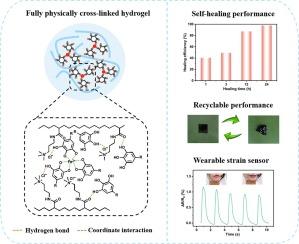Dual physical cross-linking supramolecular hydrogel with self-healing, recyclable and stretchable capabilities as wearable strain sensor for human motion monitoring
IF 5.8
2区 化学
Q1 POLYMER SCIENCE
引用次数: 0
Abstract
Hydrogel-based wearable sensors have attracted tremendous attention in the sensing electronics field due to their unique properties. However, it remains a challenge to explore hydrogel-based sensor that can incorporate highly stretchable, self-healing, and recyclable properties simultaneously. In this work, we report a simple approach to fabricate high-performance polymer hydrogels using (3-acrylamidopropyl) trimethylammonium chloride (ATAC), tannic acid (TA) and ferric chloride (FeCl3) as raw materials. There were two non-covalent interactions in the network: hydrogen bonding between PATAC and TA, and metal-coordination interaction between TA and FeCl3. Excellent mechanical properties were achieved of the PATAC-TA/Fe3+ hydrogel: fracture strain of 2234 %, fracture stress of 188.57 kPa, and toughness of 2.93 MJ/m3. Due to reversibility of the non-covalent cross-linked networks, the self-healing efficiency of the hydrogel could reach 96.62 % after 24 h of contact. At the same time, the stretchability, electrical conductivity, and self-healing property of the damaged hydrogel were recovered after dissolution and drying. Therefore, the strain sensor based on the hydrogel could be used to monitor a variety of human activities in real time, including speech recognition, facial expression recognition and joint bending. With the combination of these outstanding features, such a highly self-healing and recyclable hydrogel through a facile and green preparation process would have great potential application for sustainable wearable sensors.

具有自修复、可回收和可拉伸功能的双物理交联超分子水凝胶,可作为用于人体运动监测的可穿戴应变传感器
基于水凝胶的可穿戴传感器因其独特的性能在传感电子领域引起了极大的关注。然而,探索同时具有高拉伸性、自愈性和可回收性的水凝胶传感器仍是一项挑战。在这项工作中,我们报告了一种以(3-丙烯酰胺丙基)三甲基氯化铵(ATAC)、单宁酸(TA)和氯化铁(FeCl3)为原料制造高性能聚合物水凝胶的简单方法。网络中存在两种非共价相互作用:PATAC 和 TA 之间的氢键作用,以及 TA 和 FeCl3 之间的金属配位相互作用。PATAC-TA/Fe3+ 水凝胶具有优异的机械性能:断裂应变为 2234%,断裂应力为 188.57 kPa,韧性为 2.93 MJ/m3。由于非共价交联网络的可逆性,水凝胶在接触 24 小时后的自愈合效率可达 96.62%。同时,在溶解和干燥后,受损水凝胶的拉伸性、导电性和自愈性都得到了恢复。因此,基于水凝胶的应变传感器可用于实时监测各种人体活动,包括语音识别、面部表情识别和关节弯曲。结合这些突出特点,这种通过简便、绿色的制备过程实现高度自愈合和可回收的水凝胶将在可持续可穿戴传感器领域具有巨大的应用潜力。
本文章由计算机程序翻译,如有差异,请以英文原文为准。
求助全文
约1分钟内获得全文
求助全文
来源期刊

European Polymer Journal
化学-高分子科学
CiteScore
9.90
自引率
10.00%
发文量
691
审稿时长
23 days
期刊介绍:
European Polymer Journal is dedicated to publishing work on fundamental and applied polymer chemistry and macromolecular materials. The journal covers all aspects of polymer synthesis, including polymerization mechanisms and chemical functional transformations, with a focus on novel polymers and the relationships between molecular structure and polymer properties. In addition, we welcome submissions on bio-based or renewable polymers, stimuli-responsive systems and polymer bio-hybrids. European Polymer Journal also publishes research on the biomedical application of polymers, including drug delivery and regenerative medicine. The main scope is covered but not limited to the following core research areas:
Polymer synthesis and functionalization
• Novel synthetic routes for polymerization, functional modification, controlled/living polymerization and precision polymers.
Stimuli-responsive polymers
• Including shape memory and self-healing polymers.
Supramolecular polymers and self-assembly
• Molecular recognition and higher order polymer structures.
Renewable and sustainable polymers
• Bio-based, biodegradable and anti-microbial polymers and polymeric bio-nanocomposites.
Polymers at interfaces and surfaces
• Chemistry and engineering of surfaces with biological relevance, including patterning, antifouling polymers and polymers for membrane applications.
Biomedical applications and nanomedicine
• Polymers for regenerative medicine, drug delivery molecular release and gene therapy
The scope of European Polymer Journal no longer includes Polymer Physics.
 求助内容:
求助内容: 应助结果提醒方式:
应助结果提醒方式:


